SUZUKI KIZASHI 2010 1.G Workshop Manual
Manufacturer: SUZUKI, Model Year: 2010, Model line: KIZASHI, Model: SUZUKI KIZASHI 2010 1.GPages: 388, PDF Size: 4.94 MB
Page 51 of 388
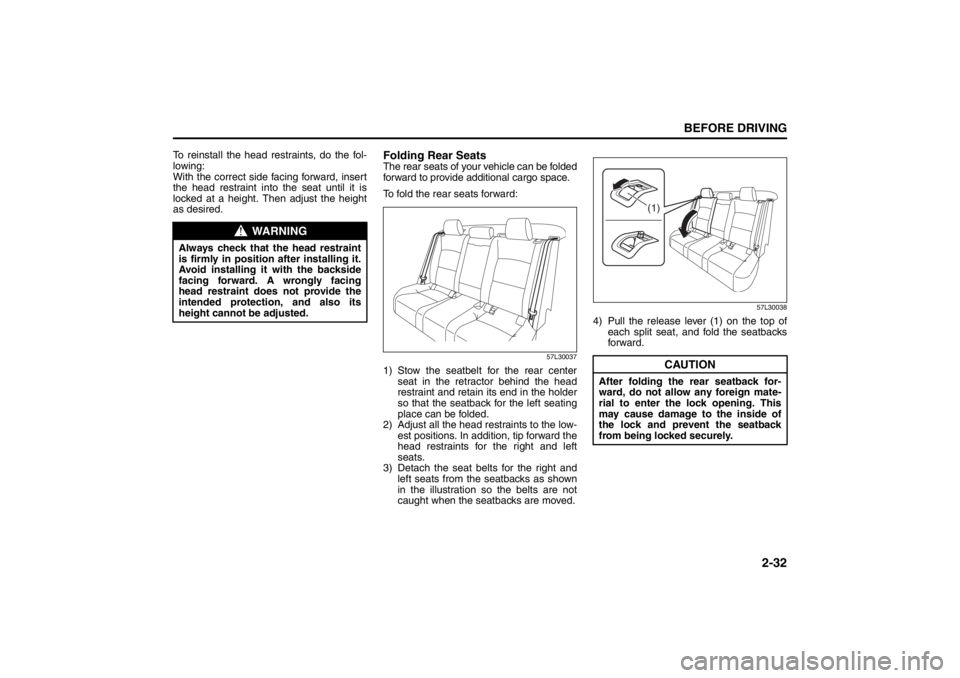
2-32
BEFORE DRIVING
57L20-03E
To reinstall the head restraints, do the fol-
lowing:
With the correct side facing forward, insert
the head restraint into the seat until it is
locked at a height. Then adjust the height
as desired.
Folding Rear SeatsThe rear seats of your vehicle can be folded
forward to provide additional cargo space.
To fold the rear seats forward:
57L30037
1) Stow the seatbelt for the rear center
seat in the retractor behind the head
restraint and retain its end in the holder
so that the seatback for the left seating
place can be folded.
2) Adjust all the head restraints to the low-
est positions. In addition, tip forward the
head restraints for the right and left
seats.
3) Detach the seat belts for the right and
left seats from the seatbacks as shown
in the illustration so the belts are not
caught when the seatbacks are moved.
57L30038
4) Pull the release lever (1) on the top of
each split seat, and fold the seatbacks
forward.
WARNING
Always check that the head restraint
is firmly in position after installing it.
Avoid installing it with the backside
facing forward. A wrongly facing
head restraint does not provide the
intended protection, and also its
height cannot be adjusted.
CAUTION
After folding the rear seatback for-
ward, do not allow any foreign mate-
rial to enter the lock opening. This
may cause damage to the inside of
the lock and prevent the seatback
from being locked securely.
(1)
Seat Belts and Child Restraint Systems: 3
Page 52 of 388
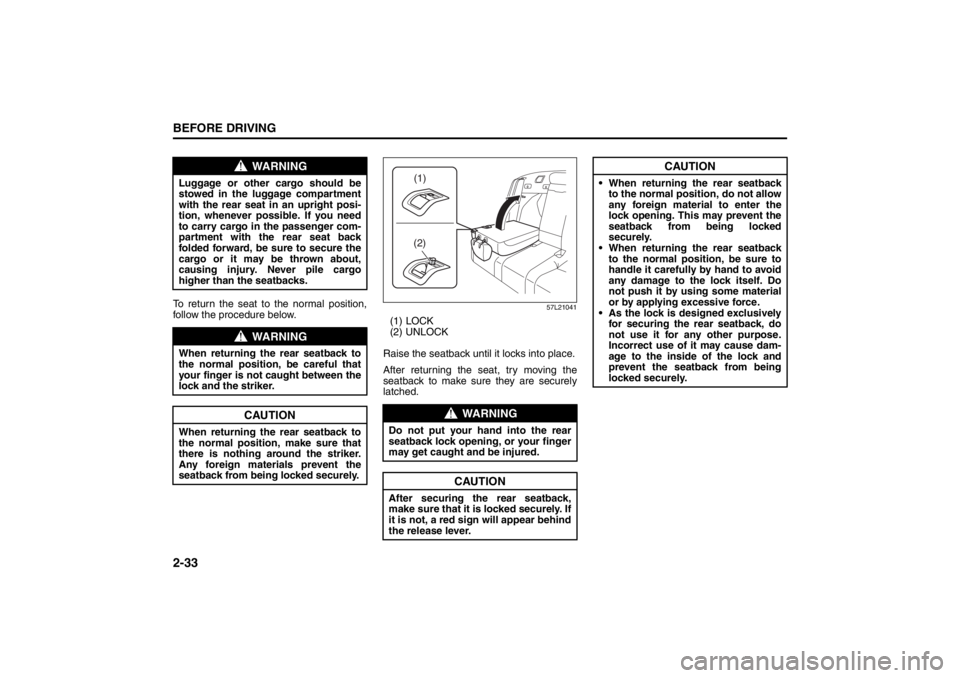
2-33BEFORE DRIVING
57L20-03E
To return the seat to the normal position,
follow the procedure below.
57L21041
(1) LOCK
(2) UNLOCK
Raise the seatback until it locks into place.
After returning the seat, try moving the
seatback to make sure they are securely
latched.
WARNING
Luggage or other cargo should be
stowed in the luggage compartment
with the rear seat in an upright posi-
tion, whenever possible. If you need
to carry cargo in the passenger com-
partment with the rear seat back
folded forward, be sure to secure the
cargo or it may be thrown about,
causing injury. Never pile cargo
higher than the seatbacks.
WARNING
When returning the rear seatback to
the normal position, be careful that
your finger is not caught between the
lock and the striker.
CAUTION
When returning the rear seatback to
the normal position, make sure that
there is nothing around the striker.
Any foreign materials prevent the
seatback from being locked securely.
WARNING
Do not put your hand into the rear
seatback lock opening, or your finger
may get caught and be injured.
CAUTION
After securing the rear seatback,
make sure that it is locked securely. If
it is not, a red sign will appear behind
the release lever.
(1)
(2)
CAUTION
When returning the rear seatback
to the normal position, do not allow
any foreign material to enter the
lock opening. This may prevent the
seatback from being locked
securely.
When returning the rear seatback
to the normal position, be sure to
handle it carefully by hand to avoid
any damage to the lock itself. Do
not push it by using some material
or by applying excessive force.
As the lock is designed exclusively
for securing the rear seatback, do
not use it for any other purpose.
Incorrect use of it may cause dam-
age to the inside of the lock and
prevent the seatback from being
locked securely.
Seat Belts and Child Restraint Systems: 3
Page 53 of 388
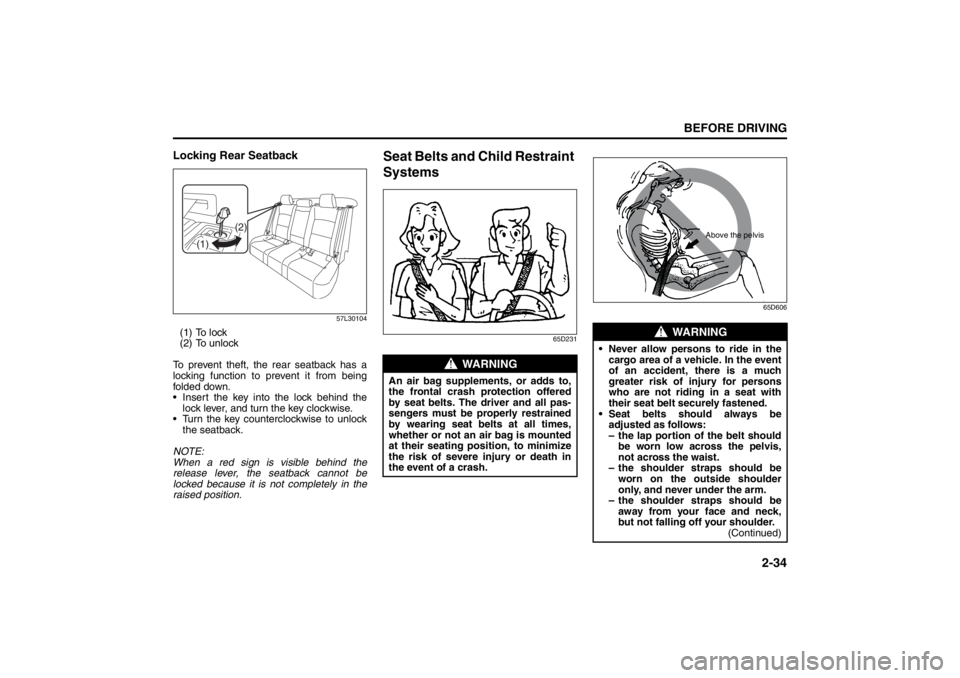
2-34
BEFORE DRIVING
57L20-03E
Locking Rear Seatback
57L30104
(1) To lock
(2) To unlock
To prevent theft, the rear seatback has a
locking function to prevent it from being
folded down.
Insert the key into the lock behind the
lock lever, and turn the key clockwise.
Turn the key counterclockwise to unlock
the seatback.
NOTE:
When a red sign is visible behind the
release lever, the seatback cannot be
locked because it is not completely in the
raised position.
Seat Belts and Child Restraint
Systems
65D23165D606
(1)(2)
WARNING
An air bag supplements, or adds to,
the frontal crash protection offered
by seat belts. The driver and all pas-
sengers must be properly restrained
by wearing seat belts at all times,
whether or not an air bag is mounted
at their seating position, to minimize
the risk of severe injury or death in
the event of a crash.
WARNING
Never allow persons to ride in the
cargo area of a vehicle. In the event
of an accident, there is a much
greater risk of injury for persons
who are not riding in a seat with
their seat belt securely fastened.
Seat belts should always be
adjusted as follows:
– the lap portion of the belt should
be worn low across the pelvis,
not across the waist.
– the shoulder straps should be
worn on the outside shoulder
only, and never under the arm.
– the shoulder straps should be
away from your face and neck,
but not falling off your shoulder.
(Continued)
Above the pelvis
Seat Belts and Child Restraint Systems: 3
Supplemental Restraint System (advanced air bags):
3, 9, 12
Page 54 of 388
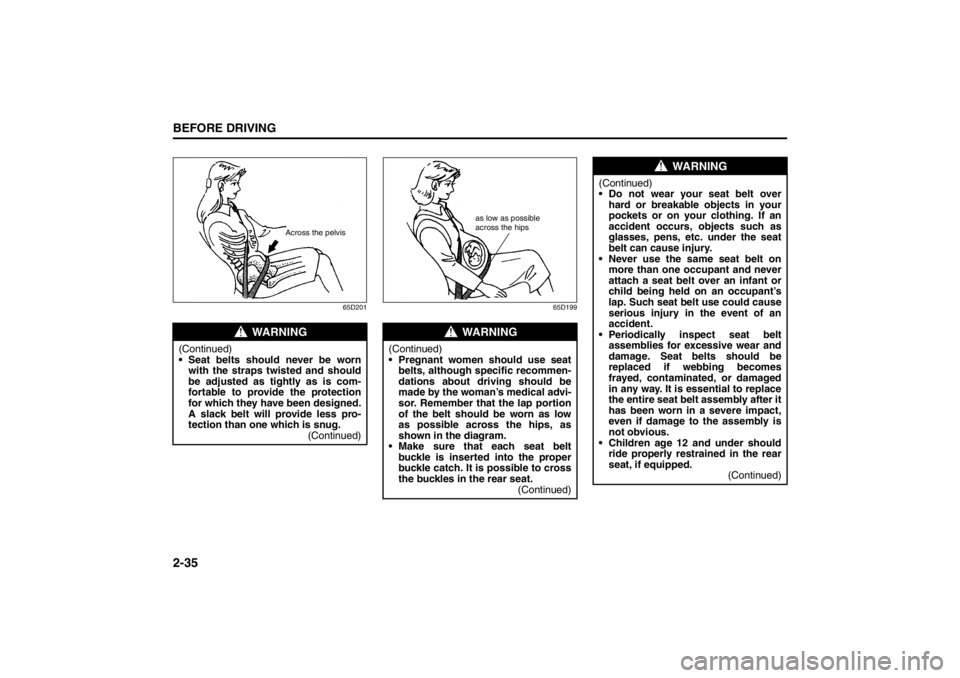
2-35BEFORE DRIVING
57L20-03E
65D201 65D199
WARNING
(Continued)
Seat belts should never be worn
with the straps twisted and should
be adjusted as tightly as is com-
fortable to provide the protection
for which they have been designed.
A slack belt will provide less pro-
tection than one which is snug.
(Continued)
Across the pelvis
WARNING
(Continued)
Pregnant women should use seat
belts, although specific recommen-
dations about driving should be
made by the woman’s medical advi-
sor. Remember that the lap portion
of the belt should be worn as low
as possible across the hips, as
shown in the diagram.
Make sure that each seat belt
buckle is inserted into the proper
buckle catch. It is possible to cross
the buckles in the rear seat.
(Continued)
as low as possible
across the hips
WARNING
(Continued)
Do not wear your seat belt over
hard or breakable objects in your
pockets or on your clothing. If an
accident occurs, objects such as
glasses, pens, etc. under the seat
belt can cause injury.
Never use the same seat belt on
more than one occupant and never
attach a seat belt over an infant or
child being held on an occupant’s
lap. Such seat belt use could cause
serious injury in the event of an
accident.
Periodically inspect seat belt
assemblies for excessive wear and
damage. Seat belts should be
replaced if webbing becomes
frayed, contaminated, or damaged
in any way. It is essential to replace
the entire seat belt assembly after it
has been worn in a severe impact,
even if damage to the assembly is
not obvious.
Children age 12 and under should
ride properly restrained in the rear
seat, if equipped.
(Continued)
Supplemental Restraint System (advanced air bags):
3, 9, 12
Page 55 of 388
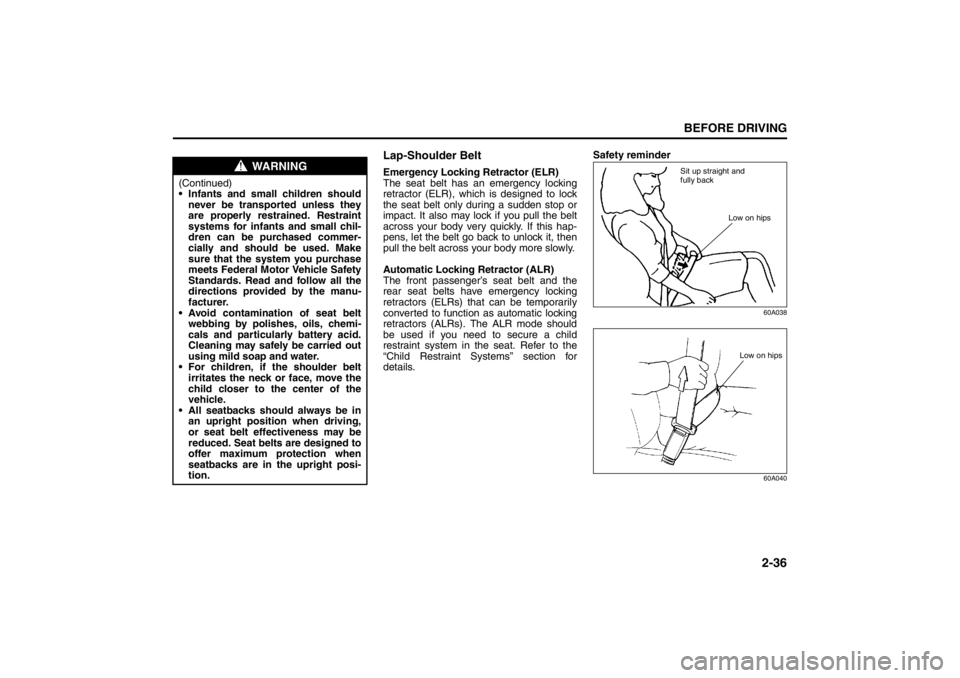
2-36
BEFORE DRIVING
57L20-03E
Lap-Shoulder BeltEmergency Locking Retractor (ELR)
The seat belt has an emergency locking
retractor (ELR), which is designed to lock
the seat belt only during a sudden stop or
impact. It also may lock if you pull the belt
across your body very quickly. If this hap-
pens, let the belt go back to unlock it, then
pull the belt across your body more slowly.
Automatic Locking Retractor (ALR)
The front passenger’s seat belt and the
rear seat belts have emergency locking
retractors (ELRs) that can be temporarily
converted to function as automatic locking
retractors (ALRs). The ALR mode should
be used if you need to secure a child
restraint system in the seat. Refer to the
“Child Restraint Systems” section for
details.Safety reminder
60A038
60A040
WARNING
(Continued)
Infants and small children should
never be transported unless they
are properly restrained. Restraint
systems for infants and small chil-
dren can be purchased commer-
cially and should be used. Make
sure that the system you purchase
meets Federal Motor Vehicle Safety
Standards. Read and follow all the
directions provided by the manu-
facturer.
Avoid contamination of seat belt
webbing by polishes, oils, chemi-
cals and particularly battery acid.
Cleaning may safely be carried out
using mild soap and water.
For children, if the shoulder belt
irritates the neck or face, move the
child closer to the center of the
vehicle.
All seatbacks should always be in
an upright position when driving,
or seat belt effectiveness may be
reduced. Seat belts are designed to
offer maximum protection when
seatbacks are in the upright posi-
tion.
Sit up straight and
fully back
Low on hips
Low on hips
Supplemental Restraint System (advanced air bags):
3, 9, 12
Page 56 of 388
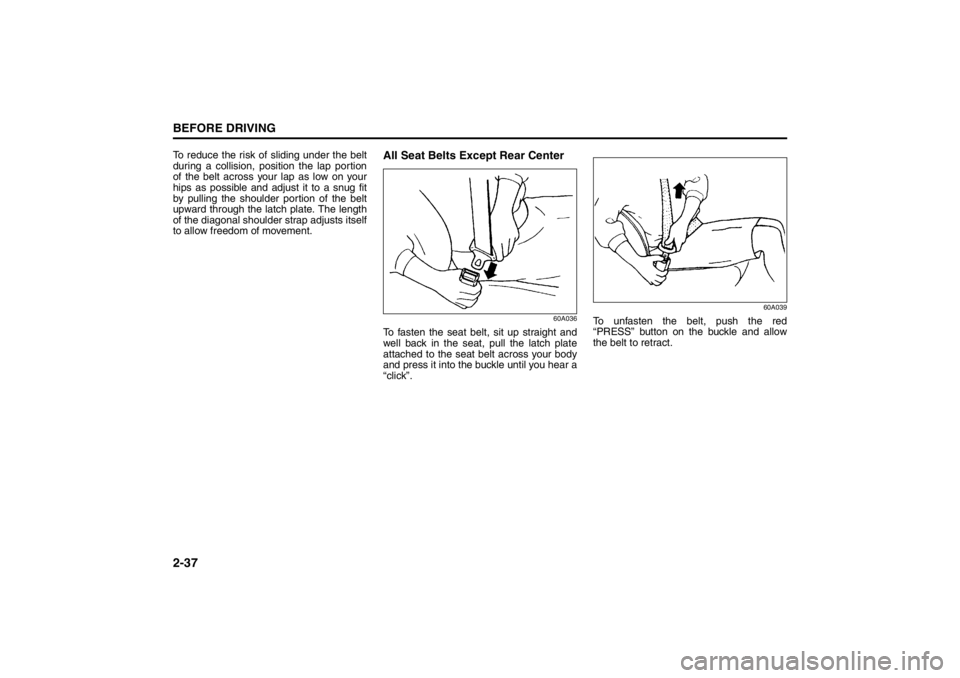
2-37BEFORE DRIVING
57L20-03E
To reduce the risk of sliding under the belt
during a collision, position the lap portion
of the belt across your lap as low on your
hips as possible and adjust it to a snug fit
by pulling the shoulder portion of the belt
upward through the latch plate. The length
of the diagonal shoulder strap adjusts itself
to allow freedom of movement.
All Seat Belts Except Rear Center
60A036
To fasten the seat belt, sit up straight and
well back in the seat, pull the latch plate
attached to the seat belt across your body
and press it into the buckle until you hear a
“click”.
60A039
To unfasten the belt, push the red
“PRESS” button on the buckle and allow
the belt to retract.
Supplemental Restraint System (advanced air bags):
3, 9, 12
Page 57 of 388
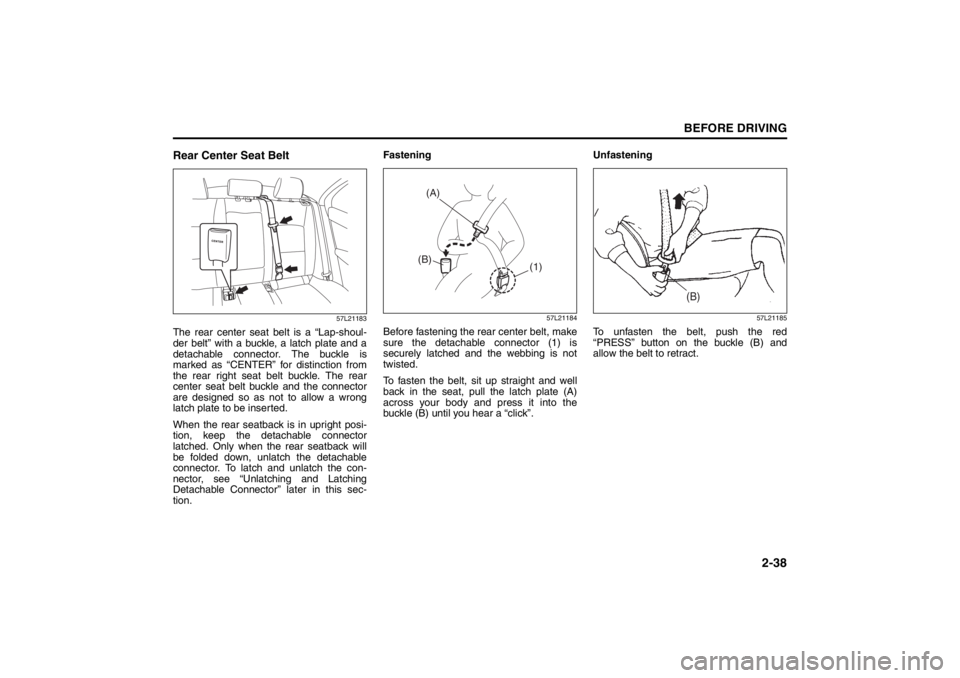
2-38
BEFORE DRIVING
57L20-03E
Rear Center Seat Belt
57L21183
The rear center seat belt is a “Lap-shoul-
der belt” with a buckle, a latch plate and a
detachable connector. The buckle is
marked as “CENTER” for distinction from
the rear right seat belt buckle. The rear
center seat belt buckle and the connector
are designed so as not to allow a wrong
latch plate to be inserted.
When the rear seatback is in upright posi-
tion, keep the detachable connector
latched. Only when the rear seatback will
be folded down, unlatch the detachable
connector. To latch and unlatch the con-
nector, see “Unlatching and Latching
Detachable Connector” later in this sec-
tion.Fastening
57L21184
Before fastening the rear center belt, make
sure the detachable connector (1) is
securely latched and the webbing is not
twisted.
To fasten the belt, sit up straight and well
back in the seat, pull the latch plate (A)
across your body and press it into the
buckle (B) until you hear a “click”.
Unfastening
57L21185
To unfasten the belt, push the red
“PRESS” button on the buckle (B) and
allow the belt to retract.
(B)
(A)
(1)
(B)
Supplemental Restraint System (advanced air bags):
3, 9, 12
Page 58 of 388
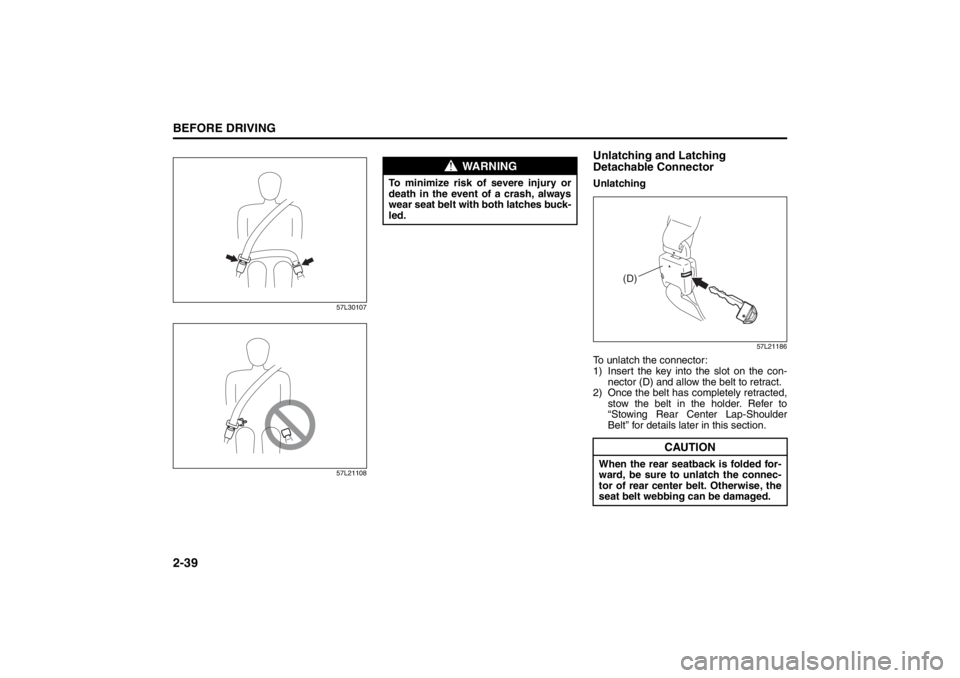
2-39BEFORE DRIVING
57L20-03E
57L30107
57L21108
Unlatching and Latching
Detachable ConnectorUnlatching
57L21186
To unlatch the connector:
1) Insert the key into the slot on the con-nector (D) and allow the belt to retract.
2) Once the belt has completely retracted, stow the belt in the holder. Refer to
“Stowing Rear Center Lap-Shoulder
Belt” for details later in this section.
WARNING
To minimize risk of severe injury or
death in the event of a crash, always
wear seat belt with both latches buck-
led.
CAUTION
When the rear seatback is folded for-
ward, be sure to unlatch the connec-
tor of rear center belt. Otherwise, the
seat belt webbing can be damaged.
(D)
Supplemental Restraint System (advanced air bags):
3, 9, 12
Page 59 of 388
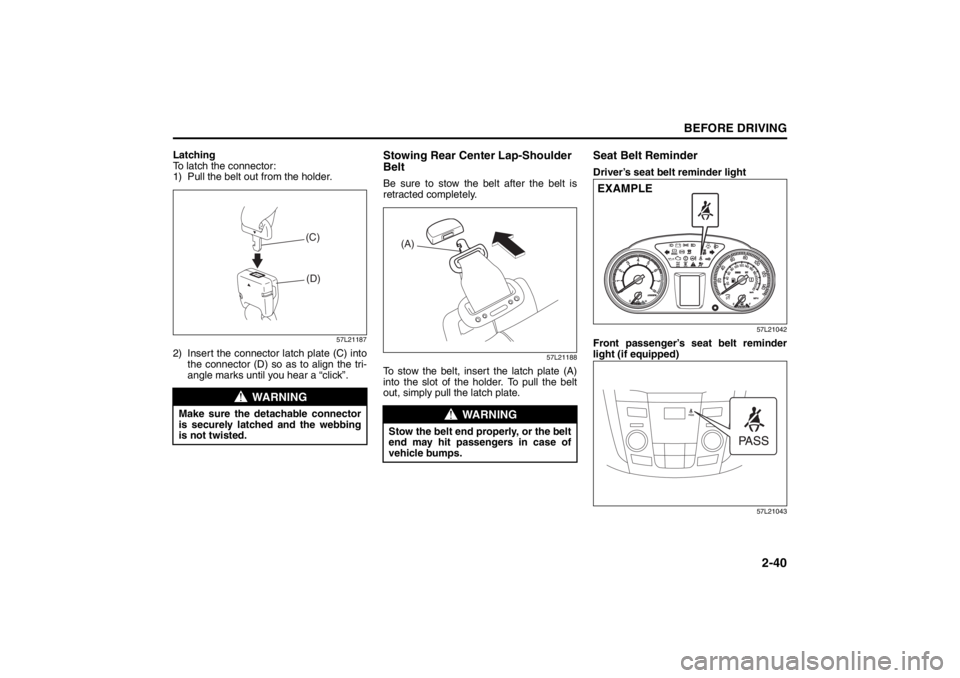
2-40
BEFORE DRIVING
57L20-03E
Latching
To latch the connector:
1) Pull the belt out from the holder.
57L21187
2) Insert the connector latch plate (C) intothe connector (D) so as to align the tri-
angle marks until you hear a “click”.
Stowing Rear Center Lap-Shoulder
BeltBe sure to stow the belt after the belt is
retracted completely.
57L21188
To stow the belt, insert the latch plate (A)
into the slot of the holder. To pull the belt
out, simply pull the latch plate.
Seat Belt ReminderDriver’s seat belt reminder light
57L21042
Front passenger’s seat belt reminder
light (if equipped)
57L21043
WARNING
Make sure the detachable connector
is securely latched and the webbing
is not twisted.
(C)
(D)
WARNING
Stow the belt end properly, or the belt
end may hit passengers in case of
vehicle bumps.
(A)
EXAMPLE
Supplemental Restraint System (advanced air bags):
3, 9, 12
Page 60 of 388
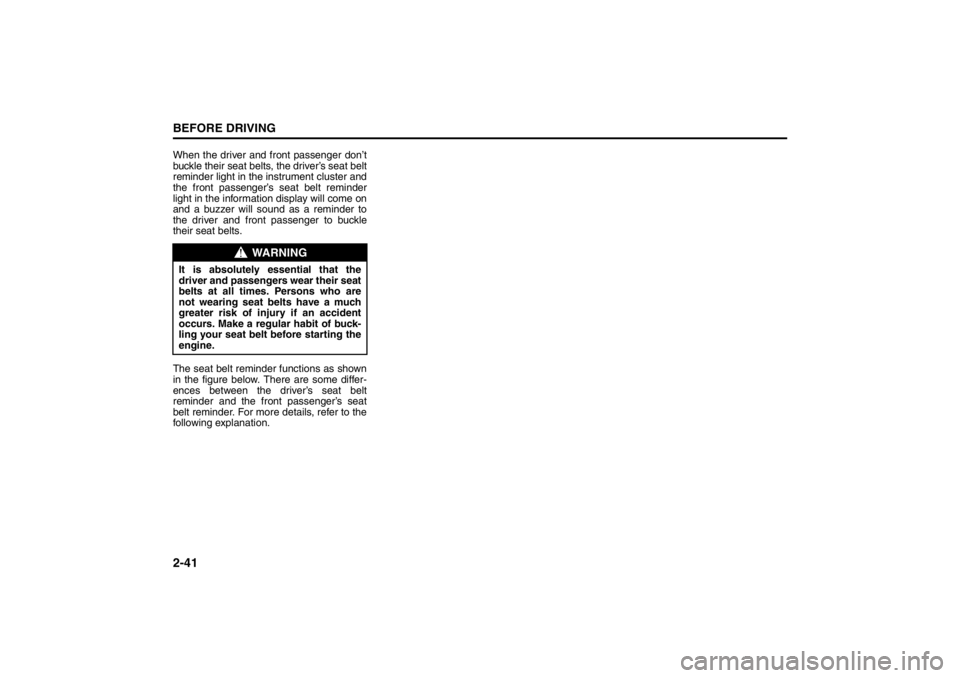
2-41BEFORE DRIVING
57L20-03E
When the driver and front passenger don’t
buckle their seat belts, the driver’s seat belt
reminder light in the instrument cluster and
the front passenger’s seat belt reminder
light in the information display will come on
and a buzzer will sound as a reminder to
the driver and front passenger to buckle
their seat belts.
The seat belt reminder functions as shown
in the figure below. There are some differ-
ences between the driver’s seat belt
reminder and the front passenger’s seat
belt reminder. For more details, refer to the
following explanation.
WARNING
It is absolutely essential that the
driver and passengers wear their seat
belts at all times. Persons who are
not wearing seat belts have a much
greater risk of injury if an accident
occurs. Make a regular habit of buck-
ling your seat belt before starting the
engine.
Supplemental Restraint System (advanced air bags):
3, 9, 12